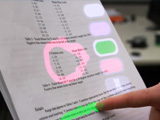|
|
TODAY.AZ / Weird / Interesting
Wearable projector and kinect-like camera turns any object into a touchscreen - VIDEO
19 October 2011 [13:53] - TODAY.AZ
 A new wearable projection system can turn any surface into an ad-hoc interactive touchscreen, from the palm of your hand to an entire wall. It combines a mini projector combined with a Kinect-type camera to capture a user’s interaction with a virtual screen.
A new wearable projection system can turn any surface into an ad-hoc interactive touchscreen, from the palm of your hand to an entire wall. It combines a mini projector combined with a Kinect-type camera to capture a user’s interaction with a virtual screen.It doesn’t need any buttons or keys — although you could probably draw one if you want — but superimposes them onto any surface you want to use. A Kinect-style infrared depth-sensing camera builds a dynamic 3-D map of your environment, using reflected infrared light to calculate surfaces even as you move around. The laser pico-projector adjusts accordingly, compensating for the surface’s shape and size to prevent distortion.
The system is able to distinguish finger-shaped cylindrical objects, and can sense whether fingers are “clicking” or hovering over something, according to a news release from Carnegie Mellon University. You can type or swipe like you would with a regular touchscreen.
For now, it’s a bulky setup worn on the shoulder, but it could eventually be minimized to become the size of a deck of cards. Co-inventor Chris Harrison, a researcher at CMU who developed the system while an intern at Microsoft, said it could eventually be integrated into future handheld devices.
Harrison also worked on a similar system we told you about last year, the Skinput, which turned a person’s hand or arm into a touchscreen. That system used acoustic sensors to detect the location of finger taps on the hands or forearm, so it was limited to the skin, which seemed cool but not necessarily as useful. By contrast, the OmniTouch system can use any surface of any size, which could make it much more practical.
The team is presenting research with OmniTouch this week at the ACM Symposium on User Interface Software and Technology in Santa Barbara.
/Popular Science/
Watch video:
URL: http://www.today.az/news/interesting/96697.html
 Print version
Print version
Views: 2443
Connect with us. Get latest news and updates.
See Also
- 19 February 2025 [22:20]
Visa and Mastercard can return to Russia, but with restrictions - 05 February 2025 [19:41]
Japan plans to negotiate with Trump to increase LNG imports from United States - 23 January 2025 [23:20]
Dubai once again named cleanest city in the world - 06 December 2024 [22:20]
Are scented candles harmful to health? - 23 November 2024 [14:11]
Magnitude 4.5 earthquake hits Azerbaijan's Lachin - 20 November 2024 [23:30]
Launch vehicle with prototype of Starship made its sixth test flight - 27 October 2024 [09:00]
Fuel prices expected to rise in Sweden - 24 October 2024 [19:14]
Turkiye strikes terror targets in Iraq and Syria - 23 October 2024 [23:46]
Kazakhstan supplied almost entire volume of oil planned for 2024 to Germany in 9 months - 23 October 2024 [22:17]
Taiwan reported passage of Chinese Navy aircraft carrier near island
Most Popular
 Western North–South route: logistics project reaches new level
Western North–South route: logistics project reaches new level
 Vietnam tackles northern air pollution
Vietnam tackles northern air pollution
 Lotte and HD Hyundai complete NCC overhaul
Lotte and HD Hyundai complete NCC overhaul
 Ankara highlights strong diplomatic performance at G20 summit in Johannesburg
Ankara highlights strong diplomatic performance at G20 summit in Johannesburg
 Istanbul Expo Centre hosts 11th World Halal Summit and Halal Expo International Trade Fair
Istanbul Expo Centre hosts 11th World Halal Summit and Halal Expo International Trade Fair
 Tarana Muradova celebrates anniversary with fascinating dance evening
Tarana Muradova celebrates anniversary with fascinating dance evening
 Erdo?an calls for fair access to healthcare at Ankara forum
Erdo?an calls for fair access to healthcare at Ankara forum
